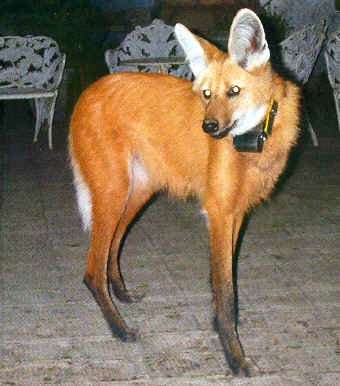
E-mail: font@focusonnature.com
Phone: Toll-free in USA 1-888-721-3555
or 302/529-1876
 |
PO
Box 9021, Wilmington, DE 19809, USA E-mail: font@focusonnature.com Phone: Toll-free in USA 1-888-721-3555 or 302/529-1876 |
THE MANED WOLF, or the "Guara"

Upcoming FONT Birding & Nature Tours in Brazil
A List of Mammals of Brazil (with some photos)
A List & Photo Gallery of Birds of Brazil, in 3 Parts
In Brazil, the cry of the Maned Wolf at night is believed to portend changes in the weather. Its gaze is said to be able to fell a chicken. These are two of the myths that shroud South America's largest and most distinctive canid. Although considered endangered throughout its range, it remains one of the least studied of the wild dogs.
The Maned Wolf is so named for the patch of long black erectile hairs across the shoulders and for its wolf-like size. But it is not a true wolf, and mostly resembles in general form and coloring a long-legged Red Fox. The tail is relatively short, the ears are erect, and the coat is softer in texture than that of many canids and lacks underfur.
It has been suggested that its long legs are an adaptation for fast running. In fact, Maned Wolves, which have a characteristic loping gait, are not particularly swift runners, and their long legs are most likely an adaptation to tall grassland habitats.
Maned Wolves are opportunists, taking small vertebrate prey up to the size of pacas, which weigh about 18 pounds. Rabbits, small rodents, armadillos, and birds are the most common prey, with occasional fish, insects and reptiles. Seasonally available fruits make up abut half the diet, the most frequent being Solanum lycarpum, known as the "fruit of the lobo" - the "wolf's fruit", which may have therapeutic properties agains the Giant Kidney Worm (dioctophyma renale), common in the Maned Wolf.
Foraging is usually done at night, some sometimes occurs in the day in areas less disturbed by man. The animals hunt alone and may cover 20 miles (32 kilometers) in the course of a night. They catch small vertebrates by using a slow stalk followed by a stiff-legged pounce similar to that of Red Foxes.
Although sexually mature after about one year, Maned Wolves probably do not breed until they are nearly two years of age. Females produce one litter (2 to 5 pups) per year, usually in June-September. The young reach adult size in about a year.
Male Maned Wolves in captivity have been observed caring for the pups, and feeding them by regurgitation. Females probably also regurgitate food to young. The breeding of the species in captivity has rarely been successful.
Little is known about the social
organization of free-living Maned Wolves. However, one study has suggested that
two adjacent, but nonoverlapping, territories of about 11 square miles (30
square kilometers) were each occupied by a monogamous pair. Although the male
and female of each pair shared the same range, they were rarely found in close
association, except during the breeding season.
In captivity, serious fighting often
occurs when individuals of the same sex are placed in the same enclosure.
Maned Wolves in the wild have been seen
to deposit feces at intervals along major pathways and to renew the marking
periodically. (We saw such droppings along the dirt road in the Canastra
National Park, where Maned Wolves occur.)
The Maned Wolf is classified by the IUCN as "vulnerable" and by the Brazilian government as "endangered". The species' range has diminished considerably during recent decades.
Maned Wolves are subject to a variety of diseases including parvovirus, as well as Giant Kidney Worm infestation. About 80 per cent of captive and sampled wild-caught individuals suffer from cystinuria, an inherited metabolic disease.
Maned Wolves are only occasionally hunted
for sport, but are frequently captured for sale to South American zoos.
In the wild, the animal is shy and
usually avoids man. Females, however, have been known to defend pups
aggressively against capture by humans.
In Brazil, parts of the Maned Wolf's body (even its feces) are said to have medicinal value, or to work as charms.
Regarding this "fox on stilts",
how did happen to be in the open grasslands of Brazil?
A poor fossil record has obscured the
origin of this South American mammal. However, it has been suggested that one or
more waves of small primitive canids may have invaded South America from North
America some 2 million years ago. These early savanna canids were probably faced
with 2 locomotion options either to go through the tall grass, or over the top of
it.
Apparently, only the Maned Wolf did the
latter. With long legs and height came large body size and thus an additional
energy requirement. Opportunistic foraging, large mutually exclusive
territories, and a tendency to pair with a single mate may all be adaptations to
a scarce and evenly distributed food supply.
As in other large carnivores of the grasslands (such as the lion of Africa), Maned Wolves have evolved simple methods of long-distance communication. The cry of the Maned Wolf is a deep-throated extended bark repeated at intervals of about seven seconds. These signals may have evolved in part as an aid to maintaining a certain level of dispersal among the animals.
At the Carara Natural Park, in Minas
Gerais, Brazil, Maned Wolves have been fed after dark on monastery steps for
many years (and thus through a number of generations of wolves).
Usually one,
sometimes two, of the large, shy animals appear late on a given night. (We've
seen them during our FONT tours at Caraca.)
It's been good here to relate to some of the known facets of these animals in the wild.
(Reference: The Encyclopedia of Mammals, edited by Dr. David Macdonald.)